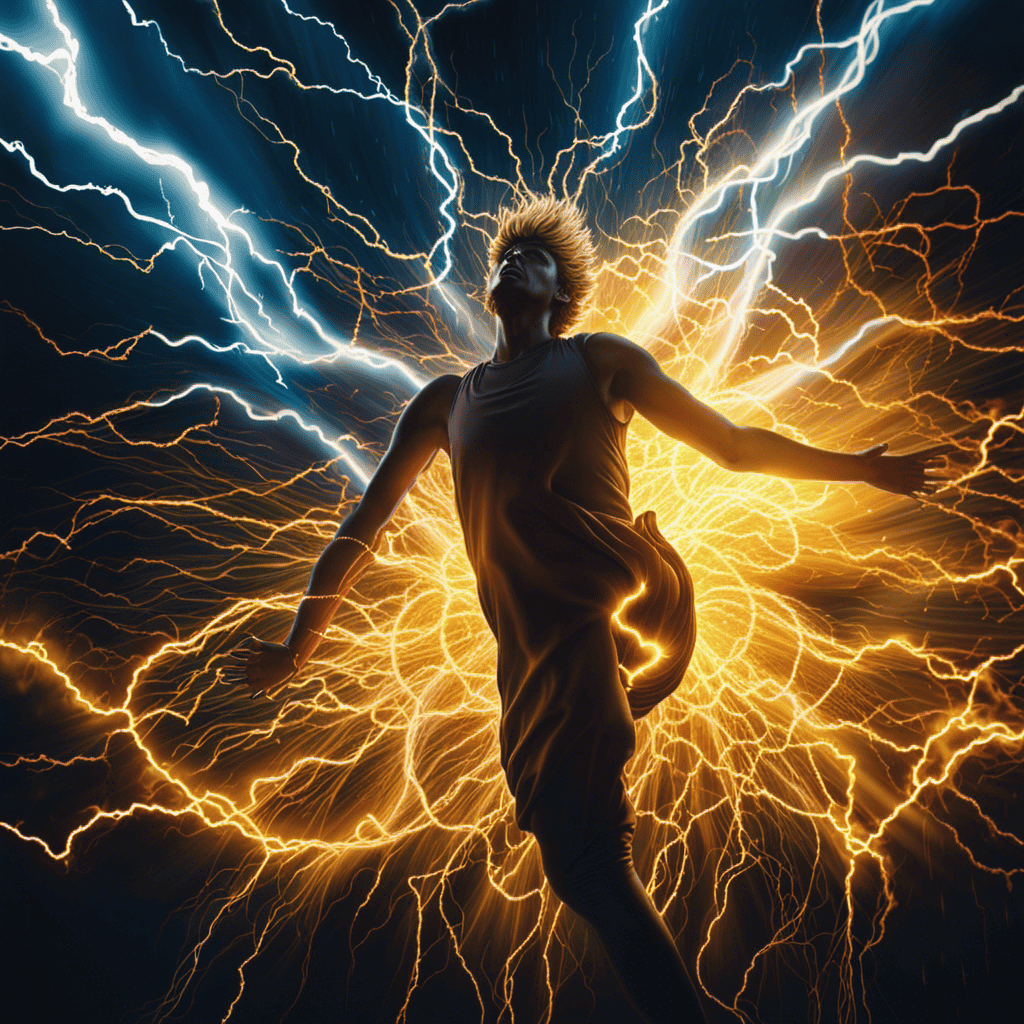Have you ever considered that the average person spends around 2 hours dreaming every night? That’s quite a substantial amount of time devoted to an experience that can feel incredibly real and vivid. But do you know which stage of sleep is typically associated with these vivid dreams?
In this article, we will explore the fascinating world of dreams and delve into the science behind them. Understanding the sleep cycle is essential when discussing dreams. Our sleep cycle consists of several stages, each with its own unique characteristics. However, it is during the stage known as REM sleep that vivid dreams most commonly occur. REM stands for Rapid Eye Movement, and it is the stage of sleep where our brain activity is most similar to when we are awake. During this stage, our eyes move rapidly, and our brain becomes highly active, often resulting in vivid and lifelike dreams.
So, let’s dive deeper into the world of REM sleep and explore the characteristics of these vivid dreams. We will also discuss the various theories on the purpose of dreaming and explore techniques to enhance dream recall. By understanding the science behind our dreams, we can gain valuable insights into the fascinating realm of our subconscious mind.
Key Takeaways
- Vivid dreams commonly occur during REM sleep.
- REM sleep is characterized by rapid eye movements and increased brain activity.
- Dreaming during REM sleep may serve various purposes such as emotional regulation, problem-solving, memory consolidation, and creativity.
- Sleep disorders can disrupt REM sleep and lead to fragmented and less vivid dreams.
Understanding the Sleep Cycle
During which stage of sleep do vivid dreams commonly occur? Understanding the sleep cycle is crucial in answering this question.
The sleep cycle consists of four stages, each with its own distinct characteristics and functions. The first three stages are non-REM (rapid eye movement) sleep, while the fourth and final stage is REM sleep.
Importance of deep sleep cannot be overstated. It is during this stage that our body repairs itself, builds up energy, and strengthens the immune system. Sleep disorders such as insomnia, sleep apnea, and restless leg syndrome can disrupt the sleep cycle, leading to a lack of deep sleep and potentially impacting the occurrence of vivid dreams.
Vivid dreams commonly occur during REM sleep. This stage is characterized by rapid eye movements, increased brain activity, and muscle paralysis. It is believed that the brain is highly active during REM sleep, processing emotions, memories, and experiences, which can manifest as vivid dreams.
Understanding the role of REM sleep in the sleep cycle is vital in comprehending the occurrence of vivid dreams. This stage is intricately linked to our cognitive processes, emotions, and overall well-being.
The Role of REM Sleep
While you’re in the midst of your slumber, your mind enters a mysterious realm known as REM sleep, where fantastical visions come alive in vibrant detail. This stage of sleep is characterized by rapid eye movement and increased brain activity. Scientists have conducted numerous studies to understand the functions of REM sleep and its relationship to dreaming.
-
REM sleep functions: During REM sleep, the brain is highly active, almost as if it’s awake. This stage is crucial for memory consolidation and learning. It’s believed that the brain processes and organizes information obtained throughout the day, strengthening important memories and discarding irrelevant ones.
-
Scientific studies on dreaming: Researchers have conducted various studies to unravel the mysteries of dreaming during REM sleep. These studies involve monitoring brain activity using techniques like electroencephalography (EEG) and functional magnetic resonance imaging (fMRI). Through these studies, scientists have discovered that vivid dreams occur most frequently during REM sleep, suggesting a strong link between this stage and the dreaming process.
-
The role of REM sleep and dreaming: The exact purpose of dreaming during REM sleep is still a subject of debate among scientists. Some theories propose that dreaming helps with emotional regulation and problem-solving, while others suggest that it may play a role in memory consolidation and creativity.
As we delve deeper into the connection between REM sleep and dreaming, we can gain a better understanding of the intricate workings of the sleeping mind.
REM Sleep and Dreaming
Immerse yourself in the fantastical realm of REM sleep, where your mind comes alive with vivid visions and your brain buzzes with activity. During REM sleep, or Rapid Eye Movement sleep, vivid dreams commonly occur. This stage of sleep is characterized by rapid eye movements, increased brain activity, and muscle paralysis. It is the stage when our most intense and memorable dreams take place.
To better understand the different stages of REM sleep, let’s take a look at the following table:
| Stage | Characteristics |
|---|---|
| Stage 1 | Light sleep, easily awakened |
| Stage 2 | Deeper sleep, less responsive to external stimuli |
| Stage 3 | Deep sleep, difficult to wake up |
| REM Sleep | Rapid eye movements, heightened brain activity |
During REM sleep, our brain is highly active, almost as if we are awake. This is also the stage when most sleep disorders, such as sleepwalking and sleep talking, occur. People with sleep disorders may experience disruptions in their REM sleep, leading to fragmented and less vivid dreams.
Transitioning into the next section about the characteristics of vivid dreams, it is important to understand how REM sleep plays a crucial role in shaping our dream experiences.
Characteristics of Vivid Dreams
Vivid dreams transport us to a world where our imagination runs wild and reality becomes a distant memory. During REM sleep, which is characterized by rapid eye movements, vivid dreams commonly occur. These dreams are often highly detailed, intense, and emotionally charged. They can feel so real that upon waking, we may struggle to distinguish them from actual memories.
Dream symbolism plays a significant role in vivid dreams. Objects, people, and scenarios within the dream can represent deeper meanings and unconscious desires. Many people turn to interpretation techniques to uncover the hidden messages within their dreams. These techniques involve analyzing symbols, themes, and emotions present in the dream to gain insight into one’s thoughts, feelings, and experiences.
Incorporating an unordered 3 item bullet list in markdown format:
- Dream symbolism helps uncover deeper meanings in vivid dreams.
- Interpretation techniques involve analyzing symbols, themes, and emotions.
- Understanding dream symbolism can provide insight into one’s thoughts and experiences.
Theories on the purpose of dreaming offer explanations for why vivid dreams occur during REM sleep. Transitioning into the subsequent section, these theories shed light on the possible functions and significance of our dream experiences.
Theories on the Purpose of Dreaming
One theory suggests that dreams serve as a window into our subconscious mind, allowing us to explore and process unresolved emotions and experiences. This theory proposes that dreams may have a symbolic nature, conveying hidden meanings that can provide insight into our innermost thoughts and desires. According to this perspective, the content of dreams is not random, but rather a reflection of our unconscious mind trying to communicate with us.
There are various theories on the symbolism in dreams. Some psychologists believe that symbols in dreams represent universal meanings, while others argue that the symbolism is highly personal and unique to each individual. Regardless of the interpretation, the symbolic nature of dreams has intrigued researchers and psychologists for centuries.
Another aspect that has been explored is the impact of dream deprivation on our mental and emotional well-being. Studies have shown that when individuals are deprived of REM sleep, the stage during which vivid dreams commonly occur, they experience heightened anxiety, irritability, and difficulty concentrating. This suggests that dreams play a crucial role in maintaining our psychological equilibrium.
Transitioning into the subsequent section about common themes in vivid dreams, it is important to understand the potential significance of these dreams in order to gain a deeper understanding of their meaning and impact on our lives.
Common Themes in Vivid Dreams
As we explore the purpose of dreaming, it’s important to acknowledge the common themes that often appear in vivid dreams. These recurring symbols and motifs can provide valuable insights into the inner workings of our minds during sleep.
Common themes in vivid dreams include flying, falling, being chased, and showing up unprepared for an important event. These dreams often evoke intense emotions and leave a lasting impression upon waking.
While the exact meaning of these symbols may vary from person to person, psychologists and dream analysts have developed techniques for interpreting dreams based on these common themes. By analyzing the context and personal associations of these symbols, one can gain a deeper understanding of their dreams and their own subconscious thoughts and desires.
This process of dream interpretation can be a valuable tool for self-reflection and personal growth. Understanding the common symbols in vivid dreams allows individuals to gain insight into their own psyche and make connections that can positively influence their waking lives.
With this understanding of common dream themes, we can now explore the fascinating concept of lucid dreaming: taking control of our dreams and actively participating in them.
Lucid Dreaming: Taking Control of Your Dreams
Imagine a world where you have the power to control and actively participate in your wildest dreams. Lucid dreaming allows individuals to do just that, providing a unique opportunity to explore the depths of their own subconscious mind.
Through various techniques and practices, one can learn to enter a state of lucidity during sleep and unleash their creative potential.
In order to achieve lucid dreaming, it’s important to understand the techniques that can be used to induce this state. Some common methods include reality testing, where individuals question their waking state throughout the day, and setting intentions before bedtime. By incorporating these strategies into your routine, you can increase your chances of experiencing lucid dreams.
Once in a lucid dream, the possibilities are endless. Here are a few examples of what one can do while in this state:
- Flying through the sky, effortlessly defying gravity.
- Exploring exotic and uncharted landscapes.
- Interacting with dream characters, perhaps even summoning specific individuals.
- Engaging in exciting adventures or reliving cherished memories.
Exploring dream interpretation and techniques for lucid dreaming opens up a world of discovery and self-exploration. By harnessing the power of lucid dreaming, individuals can gain insight into their subconscious mind and unlock their full potential.
Transitioning into the next section about factors that influence dream recall, it’s important to understand how these factors can impact our ability to remember and interpret our dreams.
Factors That Influence Dream Recall
Explore the factors that influence how well you remember and interpret your dreams, as these elements can shape the clarity and depth of your dream recall.
One important factor is dream journaling. Keeping a dream journal allows you to record your dreams immediately after waking up, helping you to remember them more vividly. By writing down the details of your dreams, you can enhance your ability to recall and interpret them later on.
Another factor that influences dream recall is sleep quality. Adequate and uninterrupted sleep is crucial for optimal dream recall. When we experience deep, restorative sleep, we’re more likely to have vivid dreams and be able to remember them upon waking. On the other hand, poor sleep quality, such as frequent awakenings or sleep disturbances, can negatively affect dream recall. Therefore, it’s important to prioritize good sleep hygiene practices to enhance your dream recall.
By understanding the factors that influence dream recall, such as dream journaling and sleep quality, you can improve your ability to remember and interpret your dreams. This knowledge can ultimately lead to a deeper understanding of your subconscious mind and inner thoughts.
Transitioning into the next section, let’s now explore some tips for enhancing dream recall.
Tips for Enhancing Dream Recall
To improve your ability to remember and interpret dreams, try incorporating these dream-enhancing tips into your routine.
First, establish a consistent sleep schedule by going to bed and waking up at the same time every day. This helps regulate your sleep cycles and increases the likelihood of dream recall.
Second, keep a dream journal by your bed and write down any dreams you remember as soon as you wake up. This practice reinforces the habit of recalling dreams and allows you to analyze them later.
Additionally, make sure to create a peaceful sleep environment by minimizing distractions and practicing relaxation techniques before bed. These can include meditation, deep breathing exercises, or listening to soothing music.
Lastly, engage in activities that stimulate your imagination and creativity, such as reading fiction or practicing artistic pursuits. This can enhance your dream recall and make your dreams more vivid.
By following these techniques for remembering dreams, you’ll be better equipped to explore the meaning of vivid dreams in the next section.
Exploring the Meaning of Vivid Dreams
Understanding the significance of intense dreams can provide valuable insights into our subconscious mind and emotional well-being. Vivid dreams, characterized by their lifelike quality and memorable content, often contain meaningful symbolism that can be subject to psychological interpretations. These dreams occur primarily during the rapid eye movement (REM) stage of sleep, which is known for its heightened brain activity and vivid imagery.
During REM sleep, our brain becomes more active, while our voluntary muscle activity is temporarily paralyzed. This state allows for the creation of elaborate dream scenarios, often filled with rich symbolism. To help visualize this concept, consider the following table:
| Symbol | Meaning | Psychological Interpretation |
|---|---|---|
| Water | Renewal | Representing a fresh start or emotional cleansing. |
| Flying | Freedom | Symbolizing liberation from constraints or a desire for independence. |
| Fire | Transformation | Signifying a period of change or personal growth. |
| Mirror | Self-reflection | Reflecting the need for introspection or self-examination. |
Analyzing the symbolism within vivid dreams can provide valuable insights into our emotions, desires, and unresolved conflicts. By exploring these dream elements, we can gain a deeper understanding of ourselves and potentially uncover hidden aspects of our subconscious mind. This knowledge can then be utilized to promote personal growth and emotional well-being.
Frequently Asked Questions
How long does each stage of sleep typically last?
Each stage of sleep typically lasts for a specific duration, with variations among individuals. The sleep cycle consists of multiple stages, including non-REM and REM sleep.
Non-REM sleep is further divided into three stages: N1, N2, and N3. The duration of each stage varies, with N1 lasting a few minutes, N2 lasting around 50% of total sleep time, and N3 accounting for approximately 20-25% of sleep duration.
These stages follow specific patterns and transitions throughout the night.
What are the physiological changes that occur during REM sleep?
One may argue that discussing the physiological changes that occur during REM sleep is unnecessary since it’s commonly known. However, understanding these changes is crucial.
During REM sleep, the body experiences rapid eye movements and increased brain activity. Breathing and heart rate become irregular, while muscle tone decreases. This state is also linked to vivid dreams.
These physiological changes play a vital role in the restorative and cognitive functions of sleep.
Can vivid dreams occur during non-REM sleep stages?
Vivid dreams can occur during non-REM sleep stages, although they’re less common compared to REM sleep. Non-REM dreams are typically less vivid and memorable. However, some individuals may experience lucid dreaming during non-REM sleep. They become aware that they’re dreaming and can actively influence the dream content. Lucid dreaming in non-REM sleep is an intriguing phenomenon. It warrants further scientific investigation to understand its underlying mechanisms and potential benefits.
Are there any known factors that can increase the occurrence of vivid dreams?
Factors such as stress, medication, and sleep disorders can increase the occurrence of vivid dreams.
Stress has been found to stimulate brain activity during sleep, leading to more intense dreams.
Certain medications, such as antidepressants and sleep aids, have also been associated with vivid dreaming as a side effect.
Additionally, sleep disorders like sleep apnea and narcolepsy can disrupt the sleep cycle, causing fragmented sleep and increasing the likelihood of vivid dreams.
These factors can have significant effects on the frequency and intensity of vivid dreaming.
Do all individuals experience vivid dreams, or is it more common in certain populations?
Vivid dream experiences and dream recall can vary among individuals. While some people may have frequent and vivid dreams, others may have less vivid or even no recollection of their dreams. Factors such as age, sleep quality, and mental health can influence the likelihood of experiencing vivid dreams.
It’s important to note that the occurrence of vivid dreams isn’t limited to a specific population and can be experienced by individuals across various demographics.
Conclusion
In conclusion, understanding the stages of sleep and the role of REM sleep is crucial in comprehending when vivid dreams commonly occur. Through REM sleep, our brains engage in intense activity, resulting in vivid and often bizarre dreams.
While the purpose of dreaming is still debated, it is clear that they play a significant role in our emotional processing and memory consolidation. For example, a case study conducted on individuals with post-traumatic stress disorder found that those who experienced more vivid dreams showed greater improvement in their symptoms after therapy.
These findings highlight the importance of exploring the meaning and potential therapeutic benefits of vivid dreams.










